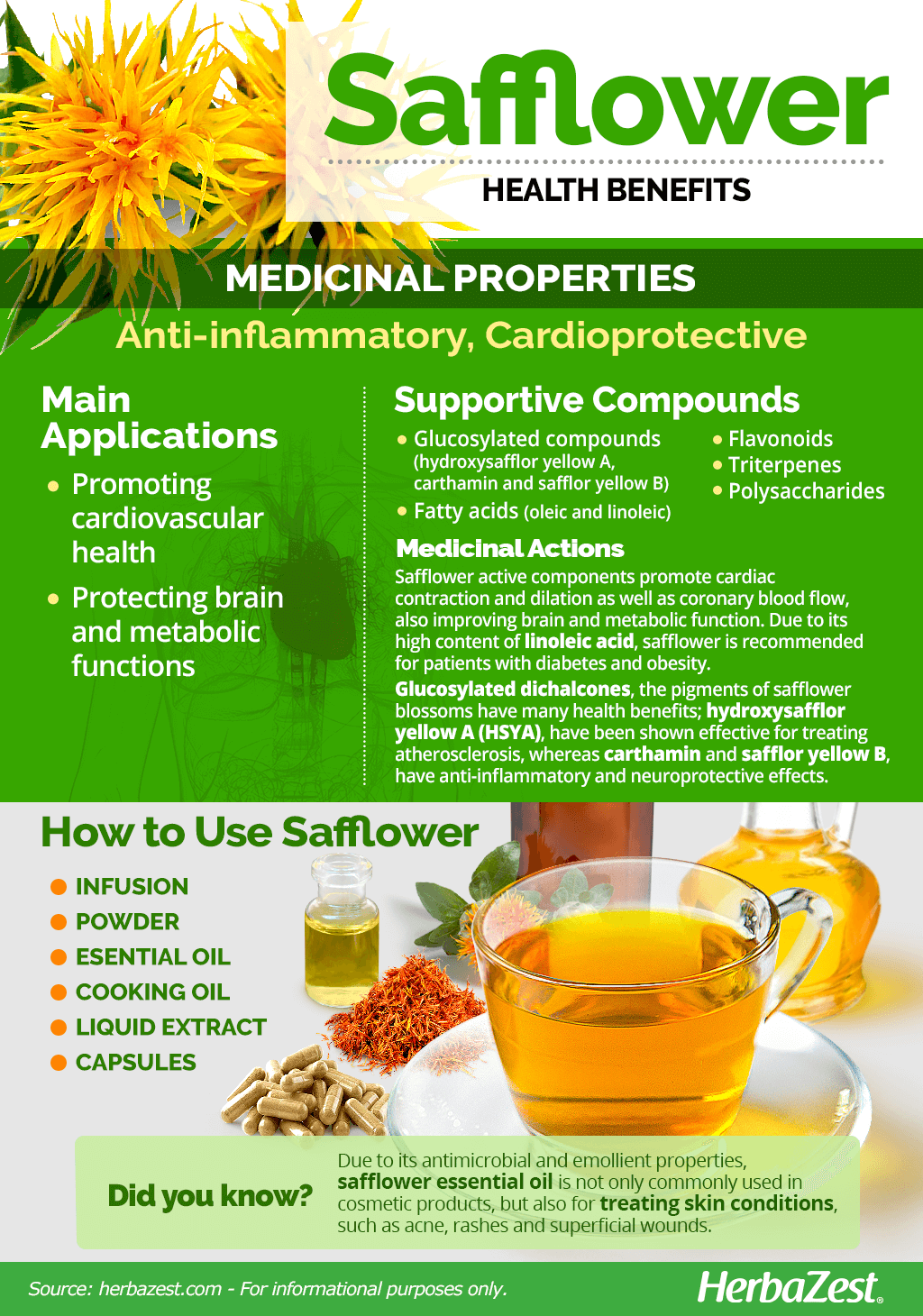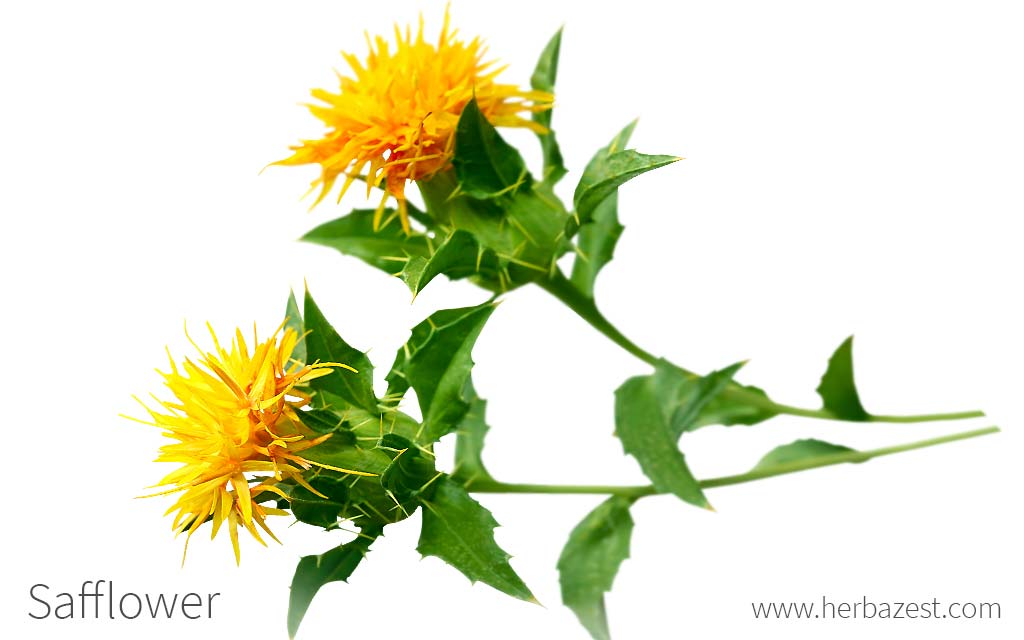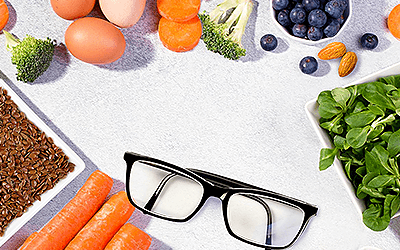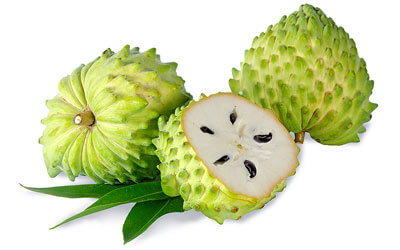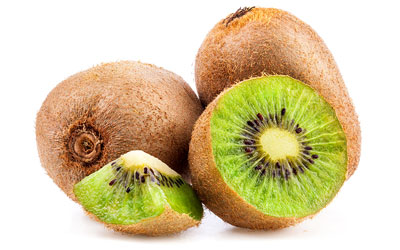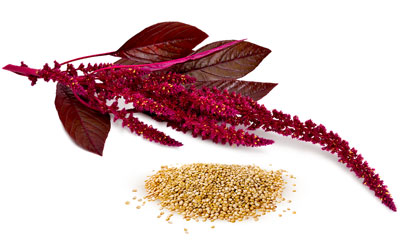Safflower's medicinal properties have been highly valued long before the advent of modern medicine. It has been used for millennia as a natural dye for textiles and paints, but also as a powerful herbal remedy for treating a variety of health conditions. Nowadays, this humble herb is well-known for its numerous health benefits.
Safflower Medicinal Properties
Health Benefits of Safflower
Multiple studies have demonstrated the antipyretic, analgesic, hormone-balancing and anti-cholesterolemic properties of safflower. Its medicinal benefits include:
Promoting cardiovascular health. Safflower's antioxidant compounds have been shown to improve blood flow, reduce inflammatory markers, and cholesterol levels, all of which can help prevent cardiovascular problems.
Protecting brain and metabolic functions. Due to its anti-inflammatory and neuroprotective properties, safflower has been shown to prevent and reduce the impact of chronic and degenerative diseases such as type 2 diabetes, obesity, and Alzheimer's.
Additionally, safflower has been successfully used in folk medicine to reduce pain and fever, control blood glucose levels, and treat mood disorders, including anxiety and depression.
How It Works
The antioxidant effects of safflower compounds are attributed to their influence on cardiac contraction, dilation, and coronary blood flow, playing an important role in preventing ischemia.1
The pigments that give sunflower its yellow and orange color (glucosylated dichalcones), particularly hydroxysafflor yellow A (HSYA), have been shown to be effective in treating atherosclerosis, a widespread condition characterized by the progressive build-up of plaque within the arteries, including cholesterol, fat, red blood cells, and calcium.2
Additionally, sunfflower's yellow and orange pigments of safflower, such as carthamin and safflor yellow B, exhibit anti-inflammatory and neuroprotective effects by reducing harmful substance like lipid peroxides and free radicals, while also improving energy metabolism.3
Safflower compounds, including glucosylated dichalcones, flavonoids, triterpenes, and polysaccharides, as well as oleic and linoleic acids, have shown to increase cholinergic neurotransmitter levels, inhibit oxidative stress and inflammation, and improve synaptic plasticity, showing great potential for the treatment of neurodegenerative diseases such as Alzheimer's disease.4,5
Due to its high content of linoleic acid (over 70%), safflower is recommended for patients with metabolic diseases like diabetes and obesity. Linoleic acid, a naturally occurring omega-6 essential fatty acid, has been shown to reduce fat mass, regulate cholesterol, and its consumption has been linked to weight loss and glycemic control.6
Thanks to its antimicrobial properties, safflower has been used to treat a variety of skin diseases, from acne to superficial wounds.7
Other herbs that are beneficial for cardiovascular health are Brazil nut, hawthorn, red clover, and rue, while gotu kola, ginkgo, and moringa promote brain health and prevent degenerative conditions.
Safflower Side Effects
Safflower products are generally safe to consume. However, some people using safflower oil may experience an unpleasant taste, diarrhea, nausea, vomiting, and stomach cramps. People with cardiovascular issues should consult to a physician before taking any safflower products, as it lowers blood pressure.
Safflower belongs to the sunflower family, so sensitive individuals may experience allergic reactions. Safflower oil is contraindicated for pregnant women, as its consumption may induce contractions.
- Medicinal action Anti-inflammatory, Cardioprotective
- Key constituents Glucosylated compounds, flavonoids, triterpenes, polysaccharides, fatty acids
- Ways to use Capsules, Hot infusions/tisanes, Liquid extracts, Powder, Essential oil
- Medicinal rating (3) Reasonably useful plant
- Safety ranking Safe

Safflower Nutrition
Safflower oil is most commonly used in the kitchen because of its reportedly healthy fatty acids, and its stability during cooking. Its consistency and color do not change at different temperatures, nor does it give off any smoke or smell when heated. The Japanese tend to mix it with other oils for tempura.
Safflower oil main nutrient is vitamin E (tocopherol), a fat soluble antioxidant that is essential for many body functions. Vitamin E is composed by a group of eight important nutrients divided in two groups: tocopherols and tocotrienols, which are metabolized and excreted by the liver, and play important roles in human health, such as protecting cellular damage caused by free radicals, improving immune resistance to virus and bacteria, and preventing blood from clotting within the arteries.
One of the reasons safflower oil is considered one of the best cooking oils is its high content of omega fatty acids, mostly omega-6 (linoleic acid), which the human body can't produce and helps reduce total and LDL cholesterol, also improving insulin sensitivity and blood pressure.
Additionally, safflower oil provides small amounts of choline and vitamin K (phylloquinone).
A tablespoon of safflower oil (about 13.6 grams) provide 120 calories and 21%DV of healthy fats.
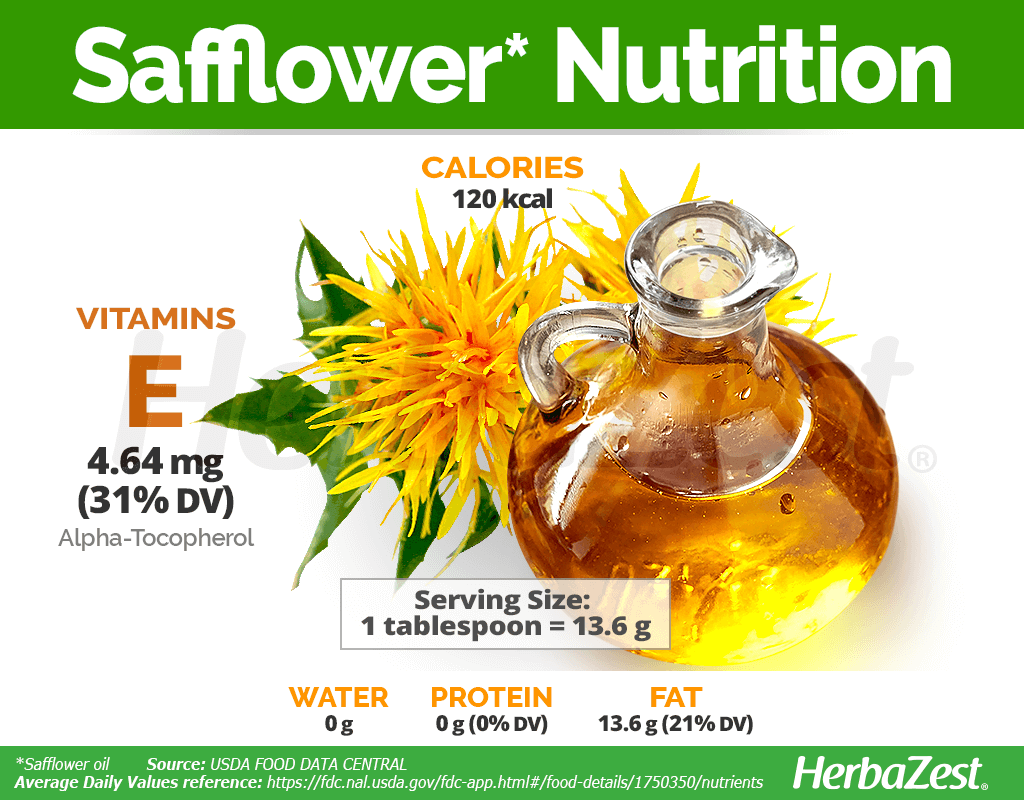
How to Consume Safflower
Safflower is a multifaceted herb that can be consumed in a number of ways. In China, the blossoms are used to make a pleasant herbal tea, and Iranian culture is known to use the seeds to make cheese. Various African countries use the seeds and ground kernels for drinks, bread, and snacks. Due to its healthy fat content, safflower oil is coveted for its use in cooking, salad dressings, and margarine.
In other parts of the world, the florets are used to add a bright orange or yellow color to food as a less costly alternative to saffron (Crocus sativus).
Natural Forms
Infusion. Fresh or dried safflower blossoms are infused in hot water to extract their healing compounds. Drinking safflower tea is thought to help with fever, jaundice, pain, and anxiety, whereas its topical application may aid in treating skin conditions and superficial wounds.
Powder. The dried and pulverized safflower blossoms can be prepared as a paste to treat skin irritations, or infused in oil or alcohol for topical use. Similarly to saffron, safflower powder can also be used for cooking as a flavoring and coloring agent, or in capsules as a dietary supplement.
Herbal Remedies & Supplements
Essential oil. Cold-pressed, pure safflower essential oil concentrates all the emollient and anti-inflammatory compounds of the herb. It is used to treat skin problems such as rashes, pimples, and acne spots, and can also be used to sanitize wounds and accelerate the healing process.
Cooking oil. Safflower cooking oil is highly valued for being rich in healthy fatty acids and vitamin E, both of which help reduce inflammation, stimulate brain function, and promote heart health. Its polyunsaturated content may be reduced by heat, but it is ideal for drizzling over steamed vegetables and making salad dressings. Additionally, it has a milder flavor than olive and coconut oils.
Liquid extract. Safflower liquid extract contains powerful antioxidant compounds such as flavonoids, polysaccharides, volatile oils, and organic acids, which have anti-inflammatory and analgesic properties that can help alleviate pain and promote cardiovascular health.
Capsules. The cardiovascular, anti-inflammatory, and neuroprotective benefits of safflower can be obtained from capsules in practical, standardized doses as a supplement.
- Edible parts Flowers, Seed
- Edible uses Oil
- Taste Mild
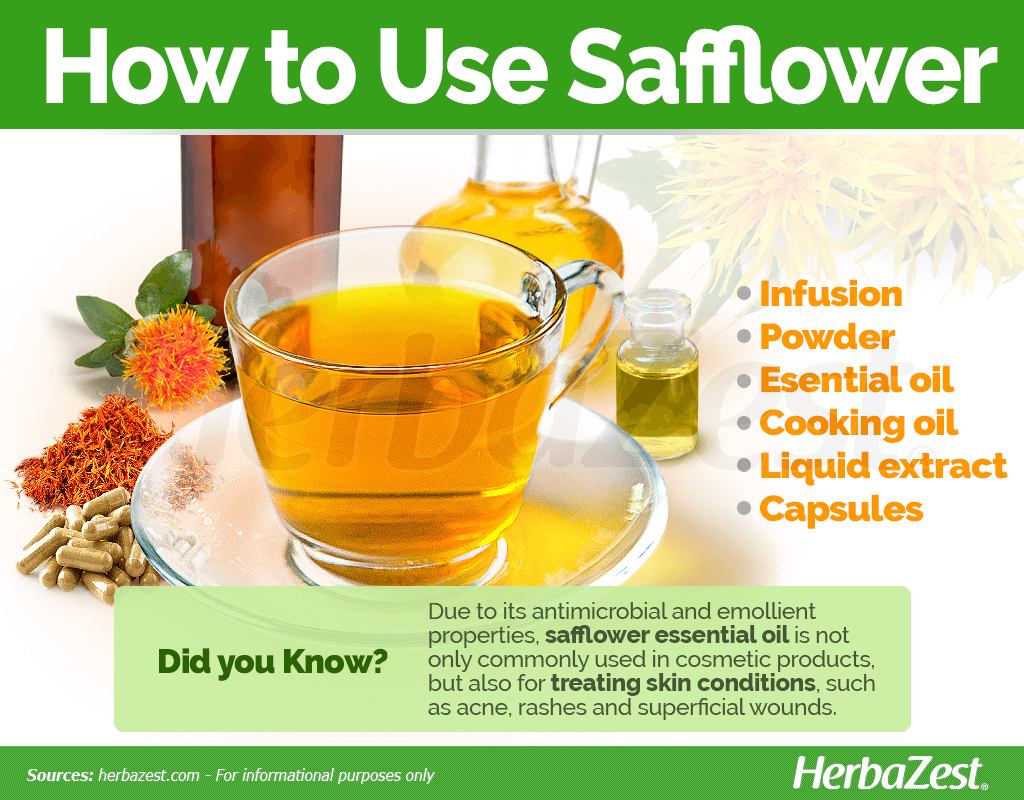
Growing
Hailing from the arid regions of India, safflower is an annual plant that thrives in dry climates and has been adapted to grow in cereal grain areas of North America and other latitudes. Safflower flowers, though small, are showy and can brighten any garden or backyard, as long as some basic requirements for soil composition, humidity, and weather conditions are met.
Growing Guidelines
This crop requires deep, fertile, well-drained soils with a high-water holding capacity and a high level of stored moisture.
Safflower does best in areas with warm temperatures and sunny, dry conditions during the flowering and seed-filling periods. Plants can tolerate temperatures as low as 20°F (-6°C) in the rosette stage; however, safflower is very sensitive to frost injury. It grows well in hot, dry climates or irrigated cropping systems, and yields are better in semi-arid regions.
Safflower seeds should be treated with a registered fungicide to control seed-borne rust and damping-off organisms. Safflower is typically planted in late April or early May, and germination begins when soil temperature exceed 40°F (4°C). Seeds usually mature in September, about four weeks after flowering ends.
Safflower buds form in late June, with flowering starting in mid to late July and continuing for two to three weeks, depending on environmental conditions, stand density, and varietal differences.
It is recommended to grow safflower in areas that receive less than 15 inches (40 cm) of annual rainfall. Extremely humid or rainy conditions increase the occurrence of leaf spot and head rot diseases.
- Life cycle Annual
- Harvested parts Flowers, Seeds
- Light requirements Full sun
- Soil Well-drained
- Growing habitat Semi-arid regions, Warm climates
- Planting time Spring
- Potential diseases Leaf spot
Additional Information
Safflower is also commonly known as "false saffron" because it is often mistaken for the much more expensive spice. However, it makes a good substitutte. This annual, herbaceous, branching plant grows both wild and cultivated in the Mediterranean region, northeastern Africa, and from southwestern Asia to India.
With spiny leaves similar in appearance to a thistle, safflower grows up to three feet (1 m) in height. Each branch of the plant grow one to five flower heads about one inch (2.5 cm) in diameter. A safflower bud will develop between 15 and 30 seeds, with a seed oil content usually between 30% and 45%. The flowers of safflower, like other species within the Carthamus genus, are pale yellow to red-orange, with tubular disk florets, although some varieties produce red or white flowers.
Classification
Safflower (Carthamus tinctorius) is a member of the Asteraceae family - commonly known as the daisy or sunflower family – along with over 23,000 other species, notably including artichoke (Cynara cardunculus), chamomile (Matricaria chamomilla), dandelion (Taraxacum officinale), lettuce (Lactuca sativa), and marigold (Tagetes erecta).
Varieties and Subspecies of Safflower
Safflower grows in over 60 countries worldwide and has numerous varieties. The Carthamus genus has been further subdivided into species with differences in height, branching, head size, and flower color. However, for industrial purposes, there are two main types of safflower: one that produces oil high in monounsaturated fatty acids (oleic acid) and another rich in polyunsaturated fatty acids (linoleic acid). Since safflower is a crop of commercial value, only varieties tolerant to Alternaria leaf spot and bacterial blight are recommended to for cultivation in the U.S.
Historical Information
The exact origin of safflower remains unknown; however, the oldest records of its domestication date back 4,000 years ago to Ancient Egypt, where it was widely cultivated both east and west of the Fertile Crescent. Traces of safflower have been found in garlands around Egyptian mummies. Traditionally, it was harvested for its flowers to make an orange dye, used for textiles and as a substitute for the more expensive saffron.
Commercial production of safflower oil began in the 1950s due to its use in the paint industry, but it is now sought after for edible products such as margarine and salad oil because of its presence of unsaturated fats, which are associated with lowering cholesterol.
The dye made from the florets of safflower has been used in European cheeses, Middle Eastern carpets, and Hebrew cosmetics. Safflower blossoms have also been enjoyed in floral arrangements in some cultures.
Economic Data
India is the largest producer of safflower oil, accounting for 50% of global production, followed by the U.S. and Mexico. Since American farmers began growing safflower around the end of World War II, this crop has significantly contributed to the development of the U.S. oil industry.
The primary producers of safflower oil in the U.S. are California and Utah. Other states producing safflower include Colorado, Idaho, Montana, North Dakota, and South Dakota. In 2014 alone, the U.S. produced 14.5 million tons (13 million tonnes) of safflower.
Other Uses
Dye. Safflower florets are used to make red and yellow dyes for food and textiles.
Industry. Safflower oil is primarily used for edible products, such as salad dressings and soft margarine. It is also used for manufacturing paints and surface coatings. "Foots" (the residue from oil processing) are used to make soap, and the seeds are used in the bird-feeding industry.
Fuel. Safflower oil can also be used as a diesel fuel substitute, but like most vegetable oils, it is currently too expensive for this purpose.
Fodder. Raw and unprocessed safflower is commonly sold for birdseed. The remaining meal from oil extraction is used as a protein supplement for livestock, containing about 24% protein and a high fiber content.
- Other uses Animal feed, Dye
Sources
- Acta Biochimica et Biophysica Sinica, Prevention of diet-induced obesity by safflower oil: insights at the levels of PPARa, Orexin, and Ghrelin gene expression of adipocytes in mice, 2010
- BCM Plant Biology, DNA sequence diversity and the origin of cultivated safflower (Carthamus tinctorius L.; Asteraceae), 2007
- Clinical Nutrition Journal, Time-dependent effects of safflower oil to improve glycemia, inflammation and blood lipids in obese, post-menopausal women with type 2 diabetes: a randomized, double-masked, crossover study, 2011
- Cureus, The Use of Safflower (Carthamus tinctorius) in Treating Depression and Anxiety, 2022
- Electronic Physician, Medical uses of Carthamus tinctorius L. (Safflower): a comprehensive review from Traditional Medicine to Modern Medicine, 2018
- Journal of Microbiology and Biotechnology, Safflower Seed Oil and Its Active Compound Acacetin Inhibit UVB-Induced Skin Photoaging, 2020
- Medicine Update, Cooking Oils in Health and Disease, 2013
- National Oilseed Processors Association
- Neurochemical Research, Antioxidant and neuroprotective activities of Mogami-benibana (safflower, Carthamus tinctorius Linne), 2009
- Promoting the Conservation and Use of Underutilized and Neglected Crops, Safflower
- SpringerPlus, Genotyping safflower (Carthamus tinctorius) cultivars by DNA fingerprints, 2005
- University of California, Expressing Achenes
- Encyclopedia of Herbal Medicine, pp. 183
- FAOSTAT
- Medicinal Plants of the World, pp. 81
- American Journal of Clinical Nutrition, Efficacy of conjugated linoleic acid for reducing fat mass: a meta-analysis in humans, 2007 | Comparison of dietary conjugated linoleic acid with safflower oil on body composition in obese postmenopausal women with type 2 diabetes mellitus, 2009
- Alternative Field Crops Manual, Safflower
Footnotes:
- Asia Journal of Pharmaceutical Research. (2015). CARDIOVASCULAR EFFECTS OF CARTHAMUS TINCTORIUS : A MINI-REVIEW. Retrieved September 12, 2024, from: https://www.researchgate.net/publication/313696318_CARDIOVASCULAR_EFFECTS_OF_CARTHAMUS_TINCTORIUS_A_MINI-REVIEW
- Phytomedicine. (2021). Hydroxysafflor yellow A, a natural compound from Carthamus tinctorius L with good effect of alleviating atherosclerosis. Retrieved September 16, 2024, from: https://www.sciencedirect.com/science/article/abs/pii/S0944711321002373
- Journal of Ethnopharmacology. (2022). Carthamus tinctorius L.: A natural neuroprotective source for anti-Alzheimer's disease drugs. Retrieved September 16, 2024, from: https://pubmed.ncbi.nlm.nih.gov/36041691/
- Journal of Ethnopharmacology. (2014). Antinociceptive and anti-inflammatory activities of extract and two isolated flavonoids of Carthamus tinctorius L. Retrieved September 16, 2024, from: https://www.sciencedirect.com/science/article/abs/pii/S0378874113008660
- Experimental Brain Research. (2007). Neuroprotective effects of safflor yellow B on brain ischemic injury. Retrieved September 16, 2024, from: https://pubmed.ncbi.nlm.nih.gov/17006684/
- Clinical Nutrition Journal. (2012). Time-dependent effects of safflower oil to improve glycemia, inflammation and blood lipids in obese, post-menopausal women with type 2 diabetes: a randomized, double-masked, crossover study. Retrieved September 12, 2024, from: https://www.ncbi.nlm.nih.gov/pmc/articles/PMC3115398/
- Oxidative Medicine and Cellular Longevity.(2020). Antioxidant and Antimicrobial Potentials of Seed Oil from Carthamus tinctorius L. in the Management of Skin Injuries. Retrieved September 17, 2024, from: https://www.ncbi.nlm.nih.gov/pmc/articles/PMC7661123/
